| | | |
This page gives a few examples of the problems encountered at the Alembic Press when we have been casting type on our Monotype Composition and Super casters. The solutions to the problems are a mixture of information taken from various Monotype publications, and from our own experience. We are by no means expert operators, and these particular solutions may not work in different circumstances, as much depends upon the general operating conditions, the condition of the caster, the state of the metal in the pot, the cleanliness of the piston and the nozzle, etc. Note that the actual pictures will be improved once a better camera has been obtained! If you have any alternative solutions, or general comments, these would be very welcome, please e-mail alembicpress@googlemail.com. A list of the other Alembic Press Monotype pages is at Information
|
 | This piece of type was being cast at twice the correct set width | On the Super caster, solved by increasing the mould blade plunger pressure. On another occasion, solved by changing to a different mould, possibly indicating dirty mould blades.
On the Composition caster, solved by cleaning the type transfer wedge rods (although the cause of the problem was never discovered). An extreme case, where the em quad became cast three ems wide, was caused by the normal wedge working loose, because it had not been properly locked in. |
| |
 | These pieces of type were progressively getting a larger indentation just above the height of a space character. | On the Composition caster, solved by cleaning the upper mould blade. A sticky blade was preventing the blade from fully opening, when running at speed.
On the Super caster, solved by increasing mould blade plunger pressure, but this probably just circumvented the cause, which was likely to have been a dirty mould blade. |
| |
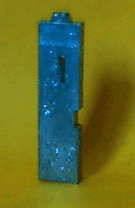 | This piece of type was being cast with a hole in the body (in some cases the hole went right through the body). | On the Composition and Super caster, solved by increasing the casting speed.
On the Super caster, hollow type was also solved by raising the metal temperature, and increasing the piston spring pressure. For both casters, this problem often occurs with the first castings, but once machine and temperature have settled, the type bodies become solid. (Depending upon ambient temperature, etc, this can be 15 minutes or 2 hours!). Note that the Manual's advice for avoiding hollow type is to slow down the casting speed. |
| |
 | The head had broken off this piece of type. Sometimes a narrow set character such as t, but often a wider set such as a or o. The draw bars were not loose, the centring pin was correctly entering the centre of the cone hole, and there was no reason to suspect worn mats, as there had been no problem the last time they had been used. | The solution was to speed up the rate of casting by some 15 rpm. The Manual advises that the caster may be too hot. |
| |
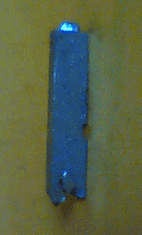 | The feet of some of the type were full of holes, ie the bottom of the body was almost all air and not metal. | Solve by increasing the piston spring pressure (tightening the screw ¼-½ inch). Or lower the casting speed (by 10-20rpm), and/or increase the mould cooling water flow, reduce metal temperature 10°F. |
| |
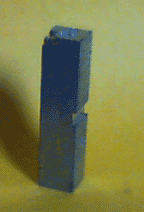 | The feet of the type were rounded, and not clean cut. (Nb the piece of type, actually an em quad, is shown upside down). | Solve by increasing the piston spring pressure. Or increase the metal temperature, reduce the mould cooling water flow. But the problem may just be that the settled working temperature of machine has not yet been reached. The Manual's advice for rounded edges (and frosted sides) is that the caster is too cold. |
| |
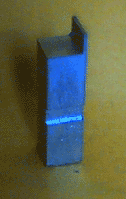 | Spacing was being cast on the Super caster with an extra type high fin on one side. | The problem was caused by the upper mould blade not opening far enough, when running at normal speed, ie mould blade opening arm was encountering too much resistance. Solved by cleaning the mould blades. |
| |
 | This piece of 6pt type was being cast with a bubble on the side of the body.(A bit difficult to see, in the picture, but there is a small swelling). | Metal too hot. Solved by reducing pot temperature, and/or increasing mould water flow. |
| |
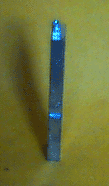 | Type being cast wider than the actual face (despite the matrices having been correctly lined up). | Character in wrong row in matrix case, or wrong set width of wedge being used. Note the extra space is to the right, indicating that the mould is being opened too far. |
| |
Now go to:
List of Alembic Monotype pages
or go to:
The International Monotype Memory Project
and for more about Alembic Press, go to:
Alembic Home Page
|









